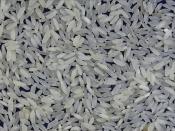Tailoring Rice To Suit Consumers
Sushi rice is sticky rice by American notions of quality texture. But stickiness is what holds the raw fish and seaweed together in that Japanese specialty.
More than half of American-grown rice is exported, so it's important to understand cultural differences when it comes to developing this widely used grain.
[See "Disease-Resistant Rice Varieties" for the latest U.S. varieties.]
Scientists with the Agricultural Research Service are using cutting-edge technology and trained sensory panelists to evaluate American rice varieties for Asian markets.
ARS chemist Franklin E. Barton heads the Quality Assessment Research Unit at Athens, Georgia. He and Elaine T. Champagne, who is in charge of ARS' Food Processing and Sensory Quality Research Unit at the Southern Regional Research Center in New Orleans, Louisiana, have traveled to Japan several times and found that consumers' tastes in food differ from Americans' in many ways.
"The Japanese palate can detect subtle nuances in rice quality that U.S.
consumers just can't perceive,"Barton says. "Here at home, most people cover their rice with gravy. But in Japan, the rice is almost an art form. The food there has to be as beautiful to look at as it is flavorful to eat."
During milling, U.S. rice processors remove the outer hull and by so doing, for white rice, remove about 15 percent by weight of the grain's outer layers. Japanese consumers like whiter rice varieties and sometimes mill their rice a little deeper.
"When I go to the store at home,"Champagne says, "there're generally one or two brands of medium- and long-grain rice. In Japan, you find rice connoisseurs who want variety and prefer their rice fresh-milled within days of purchase. In the United States, weeks or months may pass from milling to market."
There is no one right way...



Sticky
This report was very interesting. I learned a lot about rice. Very informative
0 out of 0 people found this comment useful.